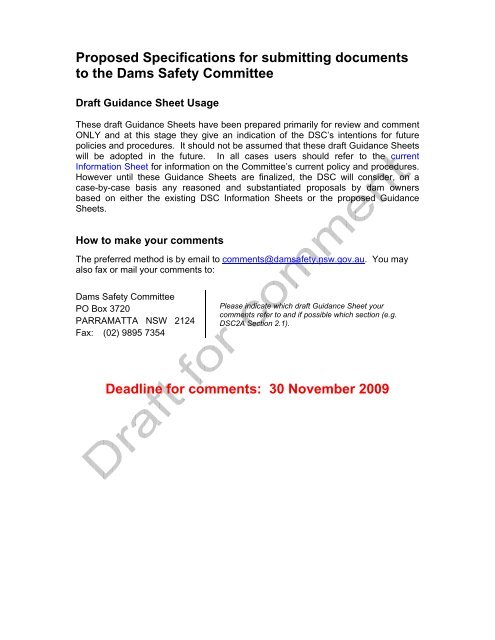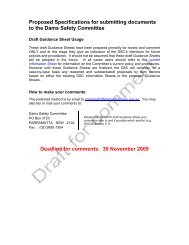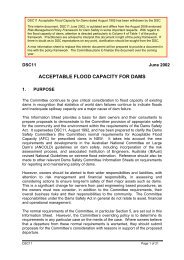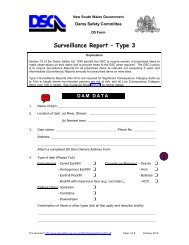Proposed Specifications for submitting documents to the Dams ...
Proposed Specifications for submitting documents to the Dams ...
Proposed Specifications for submitting documents to the Dams ...
You also want an ePaper? Increase the reach of your titles
YUMPU automatically turns print PDFs into web optimized ePapers that Google loves.
<strong>Proposed</strong> <strong>Specifications</strong> <strong>for</strong> <strong>submitting</strong> <strong>documents</strong><strong>to</strong> <strong>the</strong> <strong>Dams</strong> Safety CommitteeDraft Guidance Sheet UsageThese draft Guidance Sheets have been prepared primarily <strong>for</strong> review and commentONLY and at this stage <strong>the</strong>y give an indication of <strong>the</strong> DSC’s intentions <strong>for</strong> futurepolicies and procedures. It should not be assumed that <strong>the</strong>se draft Guidance Sheetswill be adopted in <strong>the</strong> future. In all cases users should refer <strong>to</strong> <strong>the</strong> currentIn<strong>for</strong>mation Sheet <strong>for</strong> in<strong>for</strong>mation on <strong>the</strong> Committee’s current policy and procedures.However until <strong>the</strong>se Guidance Sheets are finalized, <strong>the</strong> DSC will consider, on acase-by-case basis any reasoned and substantiated proposals by dam ownersbased on ei<strong>the</strong>r <strong>the</strong> existing DSC In<strong>for</strong>mation Sheets or <strong>the</strong> proposed GuidanceSheets.How <strong>to</strong> make your commentsThe preferred method is by email <strong>to</strong> comments@damsafety.nsw.gov.au. You mayalso fax or mail your comments <strong>to</strong>:<strong>Dams</strong> Safety CommitteePO Box 3720PARRAMATTA NSW 2124Fax: (02) 9895 7354Please indicate which draft Guidance Sheet yourcomments refer <strong>to</strong> and if possible which section (e.g.DSC2A Section 2.1).Deadline <strong>for</strong> comments: 30 November 2009
NSW DAMS SAFETY COMMITTEE (DSC)GUIDANCE SHEET DSC4DMINING NEAR PRESCRIBED DAMSCONTINGENCY PLANSTABLE of CONTENTSITEMPage1. Introduction 22. DSC Mining Safety Goal & Key Requirements 23. General DSC Requirements 34. DSC Legal Powers in an Emergency 45. Role of <strong>the</strong> DSC 46. Contacting <strong>the</strong> DSC in <strong>the</strong> Event of an Emergency 47. Possible Triggers (Action Indica<strong>to</strong>rs) 48. Contingency Actions 69. Contingency Plan Presentation 7CONSULTATION DRAFT (August 2009)The following document is a draft <strong>for</strong> consultation purposes only. If a copy ofthis document has been received, it should be used <strong>for</strong> in<strong>for</strong>mation only. Theguidance and requirements of <strong>the</strong> document are under discussion and are notyet endorsed by <strong>the</strong> NSW <strong>Dams</strong> Safety Committee (DSC).- 1 -
1.0 INTRODUCTIONThe normal requirements of <strong>the</strong> NSW <strong>Dams</strong> Safety Committee (DSC) are set out in itsguidance sheets with its principal guidance sheet, DSC Background, Functions andOperations (DSC1A),outlining <strong>the</strong> DSC’s general operations and authority.One of <strong>the</strong> DSC’s main functions is <strong>the</strong> surveillance of mining within <strong>the</strong> Notification Area ofany Prescribed Dam in NSW (see DSC4A <strong>for</strong> definitions) <strong>to</strong> ensure <strong>the</strong> safety of <strong>the</strong>Prescribed Dam and <strong>the</strong> security of its s<strong>to</strong>red water. This process involves makingrecommendations <strong>to</strong> <strong>the</strong> Minister responsible <strong>for</strong> <strong>the</strong> Mining Act 1992 in respect ofapplications <strong>to</strong> mine within Notification Areas of prescribed dams. These recommendationsspecify <strong>the</strong> extent and type of mining which may be undertaken in <strong>the</strong> vicinity of <strong>the</strong> dam and<strong>for</strong> mining near s<strong>to</strong>red waters usually require a contingency plan <strong>to</strong> be <strong>for</strong>mulated.Accordingly this Guidance Sheet, supersedes DSC35, June 1998, and is provided <strong>for</strong> <strong>the</strong>guidance and direction of mining companies on items <strong>to</strong> be included in contingency plans <strong>to</strong>minimise dam damage or s<strong>to</strong>rage loss as a result of mining under, or near, s<strong>to</strong>red waters.Companion guidance sheets indicate:• Definitions and administrative procedures involved in obtaining consent <strong>for</strong> mining withinNotification Areas (DSC4A). It includes details of <strong>the</strong> types of supporting material <strong>to</strong> beincluded with an application;• Aspects <strong>the</strong> DSC will consider be<strong>for</strong>e making recommendations on a mining application,and provides guidelines on <strong>the</strong> extent and type of mining which <strong>the</strong> DSC mayrecommend <strong>to</strong> <strong>the</strong> Minister administering <strong>the</strong> Mining Act (DSC4B); and• Some guidelines on <strong>the</strong> types of moni<strong>to</strong>ring and management conditions normallyrecommended by <strong>the</strong> DSC <strong>to</strong> <strong>the</strong> Minister (DSC4C). These guidelines are an indicationonly as variations will occur as a result of local conditions.The DSC Mining Safety Goal and Key Requirements (Section 2) are a summary-<strong>the</strong> wholesheet is <strong>to</strong> be read <strong>for</strong> a proper understanding of DSC considerations on contingencyplanning <strong>for</strong> mining near prescribed dams.2.0 DSC MINING SAFETY GOAL & KEY REQUIREMENTS2.1 DSC Mining Safety GoalThe primary goal of <strong>the</strong> DSC, relevant <strong>to</strong> this sheet, is that mining risks <strong>to</strong> prescribeddams and <strong>the</strong>ir s<strong>to</strong>rages are demonstrated <strong>to</strong> be <strong>to</strong>lerable with all <strong>the</strong>se risks:• Identified and assessed;• Reduced as low as reasonably practicable (ALARP), and as soon as reasonablypracticable, in a way that best serves community interests; and• Kept under review throughout <strong>the</strong> life cycle of <strong>the</strong> mining operations.The following sections of this sheet aim <strong>to</strong> provide direction and guidance <strong>to</strong> assistmining companies in achieving <strong>the</strong> DSC’s goal.2.2 DSC Key RequirementsThis section summarises <strong>the</strong> DSC requirements outlined in this sheet3.0 GENERAL DSC REQUIREMENTSThe DSC requires that <strong>the</strong> approval of mining under s<strong>to</strong>red waters will include arequirement that an appropriate Contingency Plan be developed <strong>to</strong> ensure water losswill be kept within <strong>to</strong>lerable limits.The Contingency Plan is required <strong>to</strong> be an “action plan”The DSC, <strong>the</strong> Department of Primary Industries (DPI) and <strong>the</strong> dam owner are <strong>to</strong> belisted as parties <strong>to</strong> be notified at an appropriate trigger level.- 2 -
4.0 DSC’s LEGAL POWERS IN AN EMERGENCYSection 18 (2) of <strong>the</strong> <strong>Dams</strong> Safety Act 1978 empowers <strong>the</strong> DSC <strong>to</strong> issue a noticerequiring any person (relevant authority, etc) <strong>to</strong> do such things as necessary <strong>to</strong>ensure <strong>the</strong> safety of a prescribed dam. Section 21 of <strong>the</strong> <strong>Dams</strong> Safety Act 1978empowers <strong>the</strong> Minister <strong>to</strong> declare a state of emergency in certain circumstances.5.0 ROLE OF THE DSCThe DSC’s role, having been alerted <strong>to</strong> an unexpected inflow is <strong>to</strong> moni<strong>to</strong>r <strong>the</strong>situation, ensure that <strong>the</strong> developed Contingency Plan is implemented by <strong>the</strong> mineowner, and <strong>to</strong> offer technical assistance where possible.6.0 CONTACTINNG THE DSC IN THE EVENT OF AN EMERGENCYMining companies are required <strong>to</strong> liaise with <strong>the</strong> DSC <strong>to</strong> obtain <strong>the</strong> contact details <strong>for</strong>pertinent DSC officers <strong>for</strong> inclusion in <strong>the</strong> Contingency Plan.7.0 POSSIBLE TRIGGERS (Action Indica<strong>to</strong>rs)Triggers should be based on physical parameters which are relevant, reliable, andreadily measured. The DSC has standard criteria <strong>for</strong> a trigger requiring notification(i.e. a low level trigger) based on water inflows.8.0 CONTINGENCY ACTIONSTable 1 lists some generic contingency actions, and provides some specificexamples relevant <strong>to</strong> <strong>the</strong> loss of s<strong>to</strong>red water.9.0 CONTINGENCY PLAN PRESENTATIONThe Contingency Plan should contain details of all relevant procedures,specifications and actions. The actual type and timing of actions will depend on <strong>the</strong>operational requirements of <strong>the</strong> particular mine, <strong>the</strong> capacity <strong>for</strong> pumping and s<strong>to</strong>ringwater underground, and <strong>the</strong> value of <strong>the</strong> s<strong>to</strong>red water.3.0 GENERAL DSC REQUIREMENTSThe purpose of a Contingency Plan is <strong>to</strong> provide effective procedures that will assist inminimising dam structure damage, or minimising water loss from <strong>the</strong> mining affected s<strong>to</strong>ragethrough a major inflow (or inrush) in<strong>to</strong> <strong>the</strong> adjacent mine workings, in <strong>the</strong> event thatunexpected conditions are encountered during mining operations. The plan is not asubstitute <strong>for</strong> adequate pre-mining investigation nor does <strong>the</strong> existence of a plan allowmining in areas that would o<strong>the</strong>rwise have an unacceptable risk. Accordingly, <strong>the</strong> DSCrequires that <strong>the</strong> approval of mining under s<strong>to</strong>red waters will include a requirement that anappropriate Contingency Plan be developed <strong>to</strong> protect <strong>the</strong> dam structure and ensure waterloss will be kept within <strong>to</strong>lerable limits.This document is intended as a guide only. Where contingency or emergency plans alreadyexist <strong>for</strong> o<strong>the</strong>r reasons it may be more appropriate <strong>to</strong> extend one of <strong>the</strong>se plans ra<strong>the</strong>r thandevelop a completely new plan.The Contingency Plan is required <strong>to</strong> be an ‘action plan’ and include:Relevant, reliable and readily measured parameters identified <strong>for</strong> use as ‘triggers’;• Identified levels or events <strong>for</strong> triggers;• Explanation of <strong>the</strong> moni<strong>to</strong>ring or o<strong>the</strong>r in<strong>for</strong>mation supporting each trigger level;• An explanation of <strong>the</strong> actions required <strong>to</strong> be implemented at each trigger level. Forexample, <strong>for</strong> mine inflows, procedures will specify levels of inflow above which keypersonnel, both at <strong>the</strong> mine and in o<strong>the</strong>r organisations, are <strong>to</strong> be in<strong>for</strong>med of <strong>the</strong>situation, and what actions are required of <strong>the</strong>se personnel;• Definition of <strong>the</strong> roles, responsibilities and contacts <strong>for</strong> persons involved in any trigger oraction;- 3 -
• Outlining <strong>the</strong> resources required <strong>to</strong> moni<strong>to</strong>r <strong>the</strong> parameters and implement any requiredactions as is <strong>the</strong> process <strong>for</strong> obtaining <strong>the</strong>se resources; and• Arrangement such that <strong>the</strong> plan can be implemented rapidly by someone in <strong>the</strong> event ofan emergency.The DSC, <strong>the</strong> Department of Primary Industries (DPI) and <strong>the</strong> dam owner are <strong>to</strong> be listed asparties <strong>to</strong> be notified at an appropriate trigger level.Where <strong>the</strong> plan calls <strong>for</strong> an action which requires <strong>the</strong> use or installation of equipment, suchas pumping inflow water or constructing bulkheads, <strong>the</strong> time required <strong>for</strong> deployment of <strong>the</strong>equipment shall be considered in <strong>the</strong> plan. Where necessary <strong>the</strong> equipment shall be s<strong>to</strong>redor installed at <strong>the</strong> commencement of mining, <strong>to</strong> be readily available.4.0 DSC’s LEGAL POWERS IN AN EMERGENCYSection 18 (2) of <strong>the</strong> <strong>Dams</strong> Safety Act 1978 empowers <strong>the</strong> DSC <strong>to</strong> issue a notice requiringany person (relevant authority, etc) <strong>to</strong> do such things as necessary <strong>to</strong> ensure <strong>the</strong> safety of aprescribed dam. Note that this includes actions in <strong>the</strong> vicinity of a prescribed dam, andunder Section 16(1), land comprising a dam includes a reference <strong>to</strong> <strong>the</strong> water or o<strong>the</strong>rmaterial impounded by a dam. Where this notice requires work at a mine <strong>to</strong> cease, <strong>the</strong>notice will be issued with <strong>the</strong> approval of <strong>the</strong> Premier. All o<strong>the</strong>r notices, <strong>for</strong> example noticesrequiring grouting, installation of bulkheads, etc, may be issued by <strong>the</strong> DSC.Section 21 of <strong>the</strong> <strong>Dams</strong> Safety Act 1978 empowers <strong>the</strong> Minister <strong>to</strong> declare a state ofemergency in certain circumstances. Once declared, <strong>the</strong> DSC, with <strong>the</strong> approval of <strong>the</strong>Minister, may “take full charge and control of … <strong>the</strong> environs under…<strong>the</strong> prescribed dam “,and can arrange all such works as are necessary.5.0 ROLE OF THE DSCThe DSC’s role, having been alerted <strong>to</strong> an unexpected situation (eg inflow) is <strong>to</strong> moni<strong>to</strong>r <strong>the</strong>situation, ensure that <strong>the</strong> developed Contingency Plan is implemented by <strong>the</strong> mine owner,and <strong>to</strong> offer technical assistance where possible. More direct action will be considered if <strong>the</strong>plan was not implemented or if it did not appear <strong>to</strong> be successful.In <strong>the</strong> event of a significant incident (eg inrush or dam distress) <strong>the</strong> DSC expects <strong>to</strong> bein<strong>for</strong>med immediately with DSC staff <strong>the</strong>n <strong>to</strong> in<strong>for</strong>m appropriate DSC members. At <strong>the</strong> sametime <strong>the</strong> DPI should be in<strong>for</strong>med, as well as <strong>the</strong> appropriate dam owner’s representative.6.0 CONTACTING THE DSC IN THE EVENT OF AN EMERGENCYAs part of <strong>the</strong> Contingency Plan, <strong>the</strong> DSC will need <strong>to</strong> be contacted in <strong>the</strong> event of anemergency. Mining companies are required <strong>to</strong> liaise with <strong>the</strong> DSC <strong>to</strong> obtain <strong>the</strong> contactdetails <strong>for</strong> pertinent DSC officers <strong>for</strong> inclusion in <strong>the</strong> Contingency Plan.7.0 POSSIBLE TRIGGERS (Action Indica<strong>to</strong>rs)Triggers should be based on physical parameters which are relevant, reliable, and readilymeasured. When considering potential loss of s<strong>to</strong>red waters as a result of undergroundmining, inflow in<strong>to</strong> <strong>the</strong> workings is usually a prime candidate <strong>for</strong> an in<strong>for</strong>mation source as it isrelevant, and usually readily measured. However, <strong>the</strong> possibility of flow paths which do notintersect <strong>the</strong> workings developing as a result of mining should be considered. O<strong>the</strong>rindicative parameters are:• Development of caving <strong>to</strong>wards a known aquifer or flow path;• Changes in groundwater levels;• Water loss from reservoir;• Unexpected ground movements at <strong>the</strong> surface, particularly at <strong>the</strong> dam structure, orunderground; or• Deterioration of pillars.- 4 -
Typically a number of trigger levels would be set. Defined in terms of <strong>the</strong> broad actionsrequired at each level, <strong>the</strong>se might include:1. Watch;2. Notify, increase surveillance, mitigate (pump);3. Investigate, slow mining;4. Prepare <strong>for</strong> remedial measures, s<strong>to</strong>p mining; and5. Implement remedial measures progressively (<strong>the</strong>re may be more than 1 stage ofremedial works)Levels <strong>for</strong> triggers may need fine tuning based on <strong>the</strong>ir per<strong>for</strong>mance in <strong>the</strong> first few months.This is particularly <strong>the</strong> case <strong>for</strong> low level triggers, such as a ‘watch’ or ‘notify’ trigger.Activating low level triggers <strong>to</strong>o frequently may reduce <strong>the</strong>ir perceived importance. Howeveran occasional (say, less than 3 times in 12 months) low level trigger will provide evidencethat <strong>the</strong> system is working.7.1 Triggers <strong>for</strong> Inflow in<strong>to</strong> Mine WorkingsAt <strong>the</strong> upper end of <strong>the</strong> scale, mining should cease when <strong>the</strong> rate or volume of loss ofs<strong>to</strong>red water approaches <strong>the</strong> <strong>to</strong>lerable limits set by <strong>the</strong> DSC. At this stage,implementation of <strong>the</strong> remedial works should have begun. Consideration will be given <strong>to</strong>recommencing mining if <strong>the</strong> loss is reduced <strong>to</strong> <strong>to</strong>lerable levels and <strong>the</strong> risk of additionalloss is considered <strong>to</strong> be acceptable by <strong>the</strong> DSC.Levels could be set based on <strong>the</strong> rate of flow, rate of change of flow, appearance of flow(discolouration), etc. The DSC has standard criteria <strong>for</strong> a trigger requiring notification(i.e. a low level trigger) based on water inflows involving:• The volume or rate of flow, or <strong>the</strong> change in <strong>the</strong> volume or rate of flow, or <strong>the</strong> flowlocation causes surprise among persons familiar with <strong>the</strong> workings;• The volume or rate of flow doubles over a few days; and• The volume or rate of flow is more than 3 standard deviations above <strong>the</strong> meanvalue (i.e. larger than about 99% of recent readings, or in <strong>the</strong> <strong>to</strong>p one percentile).In order <strong>to</strong> be reliable and readily measurable systems must be in place <strong>to</strong> determine<strong>the</strong> background levels. Usually this would involve maintaining a water balance <strong>for</strong> anarea. It may also incorporate some <strong>for</strong>m of water fingerprinting <strong>to</strong> allow discriminationbetween different sources of water. This might minimise <strong>the</strong> number of false alarmtriggers.Options <strong>for</strong> detecting water inflows include:• An awareness program <strong>for</strong> staff and an in<strong>for</strong>mal visual inspection program;• Formal visual inspections; and• Review of <strong>the</strong> water balance recordings <strong>for</strong> <strong>the</strong> mine (ie recording volume of waterpumped in an out of an area of <strong>the</strong> mine, recording volumes in holding and recordingmoisture lost from an area in coal or ore or from ventilation).Typically a program would be developed that incorporated a number of <strong>the</strong>se options.The more reliability <strong>the</strong>re is in a program, <strong>the</strong> smaller <strong>the</strong> chance that <strong>the</strong> operation isinterrupted by false alarms.The <strong>to</strong>tal volume of water is an important consideration <strong>to</strong>o, in particular if <strong>the</strong>re arelimited means of removing water from <strong>the</strong> workings. Access <strong>to</strong> certain areas will berestricted as <strong>the</strong> workings fill with water, so actions that require access <strong>to</strong> <strong>the</strong>se areasneed <strong>to</strong> be scheduled be<strong>for</strong>e access is lost.Where water is <strong>to</strong> be s<strong>to</strong>red behind plugs or dams in <strong>the</strong> workings, <strong>the</strong> pressure on <strong>the</strong>plug as a result of <strong>the</strong> height of water behind it may determine <strong>the</strong> schedule as well. For- 5 -
example, a plug may be designed <strong>for</strong> a maximum pressure equivalent <strong>to</strong> 10 m of head.A plan would need <strong>to</strong> assume that <strong>the</strong> plug will fail at this point, and that any action <strong>to</strong> bedone in <strong>the</strong> area that would be flooded by <strong>the</strong> failure of <strong>the</strong> plug needs <strong>to</strong> be completedwell be<strong>for</strong>e <strong>the</strong> pressure builds up <strong>to</strong> 10 m.8.0 CONTINGENCY ACTIONSTable 1 lists some generic contingency actions, and provides some specific examplesrelevant <strong>to</strong> <strong>the</strong> loss of s<strong>to</strong>red water. (Note that a similar approach would be required <strong>for</strong>responding <strong>to</strong> unexpected mining effects on <strong>the</strong> structural integrity of dam structures)GenericTriggerTABLE 1GENERIC ACTIONS RELATED TO TRIGGER LEVELSGeneric ActionWatch Visual inspection, orobservation of existingmoni<strong>to</strong>ring data, conductedirregularly but frequentlyduring normal operations.Notify Formal advice that anevent has occurred, or isoccurring. There may beseveral levels ofnotification (internal, DSC,DPI).IncreasesurveillanceInvestigateImplement a higherfrequency of measuremen<strong>to</strong>r observation of existingdata streams, or implementadditional moni<strong>to</strong>ringaimed at improving <strong>the</strong>understanding of <strong>the</strong>behaviour of <strong>the</strong> event.Undertake desk or on-siteinvestigations <strong>to</strong> determine<strong>the</strong> source, path, or causeof an event.Mitigate Implement measures <strong>to</strong>reduce <strong>the</strong> consequence of<strong>the</strong> eventRemediate Implement measures <strong>to</strong>reduce <strong>the</strong> causeExample of specific actions related <strong>to</strong> an inflowfrom surface s<strong>to</strong>red waterArranging <strong>to</strong> walk past and look at an area of seepageor drippers a few times during a shiftContact <strong>the</strong> DSC and advise <strong>the</strong>m that <strong>the</strong>re ispersistent leakage from a heading, that it will continue<strong>to</strong> be moni<strong>to</strong>red, and that an update will be provided<strong>to</strong>morrow.Direct seepage water <strong>to</strong> a point where it can bemeasured and recorded, so that a clearerunderstanding develops of <strong>the</strong> rate and volume ofinflow from a particular point.Drill holes <strong>to</strong> determine if a flow path from <strong>the</strong> surface<strong>to</strong> underground existsUndertake water fingerprinting <strong>to</strong> determine <strong>the</strong>sourceRe-evaluation of geological/hydrogeological modelGeophysical testing <strong>to</strong> determine water bearingfissuresTurn on existing pumps, or install additional pumps;NB this mitigates <strong>the</strong> consequence <strong>to</strong> <strong>the</strong> operationbut does nothing <strong>to</strong> mitigate <strong>the</strong> loss of s<strong>to</strong>red waterS<strong>to</strong>p miningDraw down <strong>the</strong> reservoirInstall a grout curtain or sheet, or attempt <strong>to</strong> grout aspecific flow pathSeal <strong>the</strong> area of <strong>the</strong> mine where <strong>the</strong> s<strong>to</strong>red water isentering- 6 -
9.0 CONTINGENCY PLAN PRESENTATIONThe Contingency Plan should contain details of all relevant procedures, specifications andactions. This would include:• <strong>the</strong> capacity of <strong>the</strong> pumping system;• capacity of <strong>the</strong> underground s<strong>to</strong>rage facilities;• design of <strong>the</strong> bulkheads;• <strong>the</strong> name, position, and role of key personnel; and a contact telephone list;• a statement of grouting procedures and <strong>the</strong> applicability of <strong>the</strong>se procedures <strong>to</strong> likelyinflow mechanisms; and• A timeline <strong>for</strong> <strong>the</strong> implementation of critical elementsThe actual type and timing of actions will depend on <strong>the</strong> nature and severity of <strong>the</strong> event and<strong>the</strong> operational requirements of <strong>the</strong> particular mine, <strong>the</strong> capacity <strong>for</strong> pumping and s<strong>to</strong>ringwater underground, and <strong>the</strong> value of <strong>the</strong> s<strong>to</strong>red water.It is vital that Contingency Plans are understandable. Some basic principles might include:• A guide (flowchart, table, or brief explanation) which facilitates <strong>the</strong> use of <strong>the</strong> plan in anemergency situation should be included close <strong>to</strong> <strong>the</strong> front of <strong>the</strong> plan;• While some background in a plan is desirable, lengthy sections which are not essential<strong>to</strong> <strong>the</strong> aim of <strong>the</strong> plan should be avoided. Details are best kept in an Appendix;• Text should be succinct. Where possible it should be augmented by clear diagrams;• Breaking a plan in<strong>to</strong> sub-plans can facilitate preparation and maintenance of <strong>the</strong> plan.However usability may decrease if <strong>the</strong>re are a large number of sub-plans;• The relationship between sub-plans and <strong>the</strong> main plan should be very clear, specified ineach of <strong>the</strong> sub-plans and in <strong>the</strong> main plan; and• The overlap between plans should be minimised as overlap will increase <strong>the</strong> likelihood ofconflicts between plans and present difficulties when <strong>the</strong> plan requires updating.Desk checks should be run on <strong>the</strong> plan. These can be done by assuming a scenario andrunning through <strong>the</strong> plans step by step. If a high level of confidence is required in <strong>the</strong> plan<strong>the</strong>n a more exhaustive check, involving <strong>the</strong> team of people who would be required <strong>to</strong>implement <strong>the</strong> plan, can be run.- 7 -






